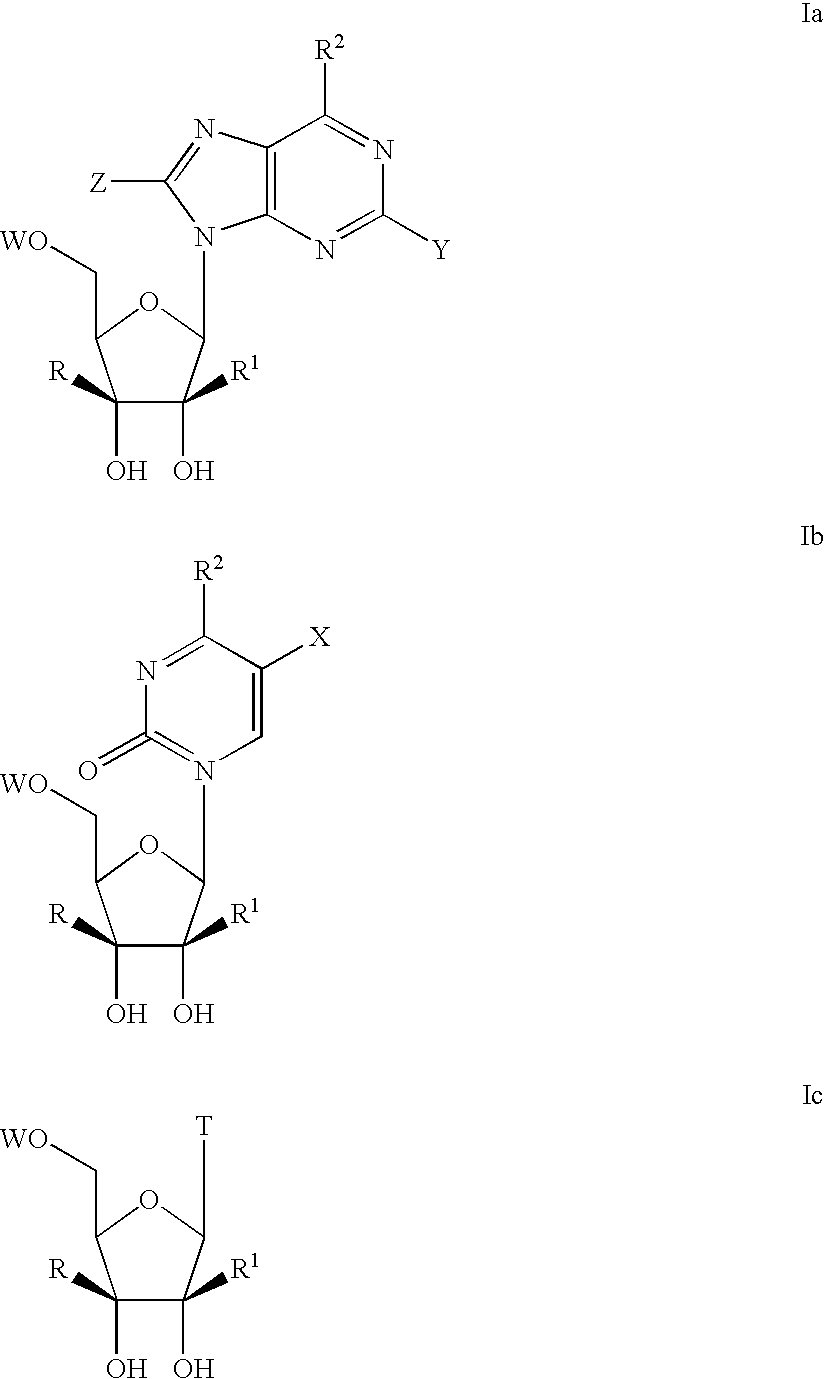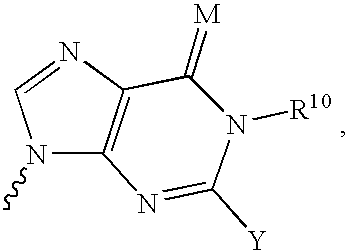Nucleoside derivatives for treating hepatitis C virus infection
a technology of hepatitis c virus and nucleoside derivatives, which is applied in the field of nucleoside derivatives for treating hepatitis c virus infection, can solve the problems of liver failure or liver cancer, death, and hcv is difficult to treat, and no effective immunization is currently availabl
- Summary
- Abstract
- Description
- Claims
- Application Information
AI Technical Summary
Problems solved by technology
Method used
Image
Examples
example 6
[0464] Synthesis of 1-(2'-C-methyl-.beta.-D-ribofuranosyl)-4-thiophen-3-yl--1H-pyrimidin-2-one (17)
[0465] 9-(2'-C-methyl-.beta.-D-ribofuranosyl)-uracil (43) (1 mmol) is dissolved in dichloromethane (10 mL) under argon and 2,6-di-tert.butyl-4-methylpyridine (3 mmol) is added. The solution is cooled to 0.degree. C. and trifluoromethanesulfonic anhydride (3 mmol) is added and the reaction is allowed to warm to ambient temperature. After 12 hours the reaction is concentrated in vacuo and chromatographed on silica gel (ethyl acetate / dichoromethane). The product is dissolved in toluene (10 mL) and then K.sub.2CO.sub.3 (200 mg, 1.5 mmol), 3-thiopheneboronic acid (1.5 mmol) and Pd(PPh.sub.3).sub.4 (59 mg, 0.05 mmol) are added and the mixture is stirred under argon at 100.degree. C. for 8 h. After cooling to ambient temperature the mixture is evaporated in vacuo and the residue is chromatographed on a silica gel column. The residue is taken up into 10 mL NH.sub.3 saturated MeOH and is reacte...
example 7
[0466] Synthesis of 1-(2'-C-methyl-.beta.-D-ribofuranosyl)-4-cyclopentyl-1-H-pyrimidin-2-one (21)
[0467] 9-(2'-C-methyl-.beta.-D-ribofuranosyl)-uracil (43) (1 mmol) is dissolved in dichloromethane (10 mL) under argon and 2,6-di-tert.butyl-4-methylpyridine (3 mmol) is added. The solution is cooled to 0.degree. C. and trifluoromethanesulfonic anhydride (3 mmol) is added and the reaction is allowed to warm to ambient temperature. After 12 hours the reaction is concentrated in vacuo and chromatographed on silica gel (ethyl acetate / dichoromethane). The product is dissolved in anhydrous THF (10 mL) and Pd(PPh.sub.3).sub.4 (59 mg, 0.05 mmol) is added under Ar atmosphere. Cyclopentylzinc bromide (1.5 mmol, 0.5 M in THF) is then added and the reaction stirred at ambient temperature for 18 hours. The mixture is evaporated in vacuo and the residue is chromatographed on a silica gel column. The residue is taken up into 10 mL NH3 saturated MeOH and reacted at 55.degree. C. for 12 hours in a seale...
example 8
[0468] Synthesis of 9-(2'-C-methyl-.beta.-D-ribofuranosyl)-6-methylthio-pu-rine (49)
[0469] 9-(2'-C-methyl-.beta.-D-ribofuranosyl)-6-methylthio-purine (49) is synthesized as described in R. Harry-O'kuru, J. Smith, and M. Wolf J. Org. Chem. 1997, 62, 1754-1759.
PUM
 Login to View More
Login to View More Abstract
Description
Claims
Application Information
 Login to View More
Login to View More - R&D
- Intellectual Property
- Life Sciences
- Materials
- Tech Scout
- Unparalleled Data Quality
- Higher Quality Content
- 60% Fewer Hallucinations
Browse by: Latest US Patents, China's latest patents, Technical Efficacy Thesaurus, Application Domain, Technology Topic, Popular Technical Reports.
© 2025 PatSnap. All rights reserved.Legal|Privacy policy|Modern Slavery Act Transparency Statement|Sitemap|About US| Contact US: help@patsnap.com



